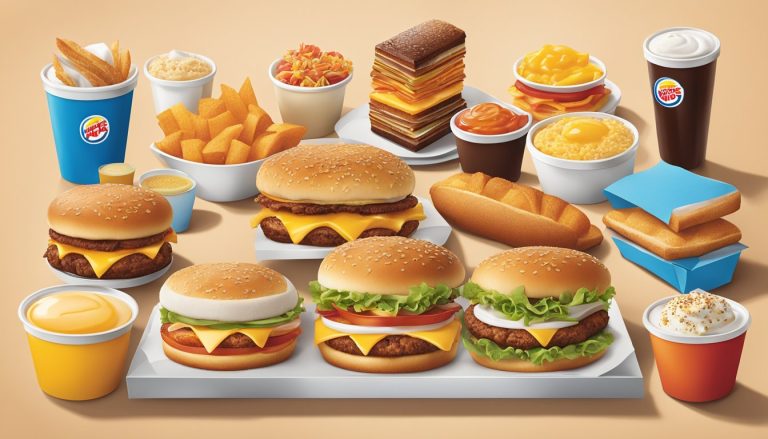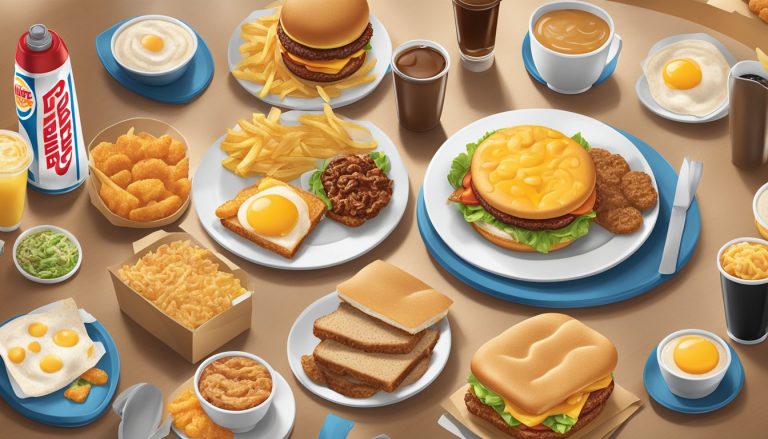Burger King’s breakfast menu has been a staple since the 1970s, making them one of the pioneers in fast food morning offerings. Among their various breakfast items, BK’s Breakfast Potatoes have emerged as a standout option. These crispy, golden potatoes have become a key driver in the resurgence of morning traffic at Burger King restaurants.
The popularity of breakfast potatoes extends beyond Burger King, with industry data showing a 15.6% increase in potato servings during breakfast across restaurants in the past year. This trend aligns with the overall growth in breakfast visits, which accounted for 22% of all restaurant visits in early 2023. For Burger King, capitalizing on this potato-driven breakfast boom could be a game-changer in the competitive fast food landscape.
As consumers seek satisfying and familiar breakfast options, BK’s Breakfast Potatoes offer a comforting side dish that pairs well with other menu items. Their versatility and widespread appeal make them a strategic choice for Burger King to attract more morning customers and potentially boost their breakfast market share.
Historical Context of Burger King

Burger King’s journey from a small Florida restaurant to a global fast-food powerhouse spans several decades. The company’s growth and menu evolution reflect changing consumer tastes and dining trends.
Rise of Burger King Breakfast Menu
Burger King introduced its breakfast menu in the late 1970s, expanding beyond its traditional lunch and dinner offerings. The move aimed to capture the morning rush and compete with other fast-food chains. Initially, the breakfast menu featured basic items like eggs, bacon, and toast.
As demand grew, Burger King expanded its morning options. The company introduced the Croissan’wich in 1983, combining a croissant with breakfast staples. This innovative sandwich helped Burger King stand out in the competitive breakfast market.
Evolution of Breakfast Options
Over the years, Burger King’s breakfast menu has undergone significant changes. The chain added healthier options like oatmeal and fruit smoothies to cater to health-conscious customers. They also introduced heartier items such as breakfast burritos and pancakes.
In 2014, Burger King made waves by launching the Burgers for Breakfast program. This move allowed customers to order Whoppers and other popular lunch items during morning hours. The strategy aimed to differentiate Burger King from competitors and appeal to non-traditional breakfast eaters.
More recently, Burger King has focused on value offerings for breakfast. The chain introduced a $1 breakfast menu in 2020, featuring items like bacon cheeseburgers and French toast sticks. This approach targets budget-conscious consumers and aims to increase morning traffic.
Analyzing the Breakfast Potato Craze
Breakfast potatoes have become a staple in fast-food morning menus, with Burger King’s offering gaining significant popularity. The crispy texture, savory flavor, and versatility of these potatoes have contributed to their widespread appeal.
Ingredients and Flavor Profile
BK’s breakfast potatoes are made from high-quality, fresh-cut potatoes. They are seasoned with a blend of salt, pepper, and proprietary spices that enhance their natural flavor. The potatoes are cut into small, bite-sized pieces to ensure even cooking and maximum crispiness.
The cooking process involves par-frying the potatoes before a final fry to order. This method results in a golden-brown exterior and a fluffy interior. The seasoning adheres well to the crispy surface, creating a flavorful bite with every piece.
BK’s breakfast potatoes offer a satisfying balance of salt and subtle spices. The flavor profile is designed to complement other breakfast items without overpowering them.
Comparison with Traditional Breakfast Sides
Compared to traditional breakfast sides like toast or pancakes, BK’s breakfast potatoes provide a savory alternative. They offer a different texture and flavor profile that many customers find appealing.
Unlike hash browns, which are typically shredded and formed into patties, BK’s breakfast potatoes are chunky and irregularly shaped. This gives them a more rustic, home-style appearance and texture.
Nutritionally, breakfast potatoes are a source of complex carbohydrates and fiber. They can be more filling than some other breakfast sides, potentially increasing customer satisfaction.
The versatility of breakfast potatoes allows them to pair well with various breakfast items, from eggs to breakfast sandwiches.
The Appeal of BK’s Crispy Potatoes
The crispy exterior of BK’s breakfast potatoes is a key factor in their popularity. The contrast between the crunchy outside and soft inside creates a satisfying texture experience.
The portion size of BK’s breakfast potatoes is generous, providing good value for money. This aspect is particularly important in the competitive fast-food breakfast market.
The potatoes’ ability to retain heat and crispiness for a reasonable time makes them suitable for both dine-in and take-out orders. This quality is crucial for customers who may be eating on the go.
BK’s breakfast potatoes also serve as a versatile base for customization. Customers can add toppings or condiments to suit their taste preferences, enhancing the overall breakfast experience.
Nutritional Information

BK’s breakfast potatoes pack a caloric punch while offering some nutritional benefits. They contain a mix of macronutrients and fiber that can contribute to a hearty morning meal.
Calorie Count and Health Aspects
A typical serving of BK’s breakfast potatoes contains approximately 170 calories. This calorie count comes from a mix of carbohydrates, fats, and proteins. The potatoes provide about 14% of the daily recommended fiber intake, which aids digestion and promotes feelings of fullness.
The carbohydrate content makes up roughly 46% of the total calories, while fats account for 47%. This high fat percentage may be due to the cooking method, likely involving oil or butter.
Sodium levels in fast food items are often high. Consumers watching their salt intake should be mindful of this when incorporating these potatoes into their breakfast.
Protein Content and Dietary Consideration
Protein makes up about 7% of the calories in BK’s breakfast potatoes. While not a significant protein source, they can complement other protein-rich breakfast items.
For those following specific diets:
- Low-carb: May not be suitable due to high carbohydrate content
- Vegetarian: Likely acceptable, but confirm preparation methods
- Gluten-free: Potentially safe, but cross-contamination risks exist
The potatoes’ nutritional profile can fit into a balanced diet when consumed in moderation. Pairing them with lean proteins and vegetables can create a more nutritionally complete meal.
Individuals with dietary restrictions or health concerns should consult nutrition information provided by Burger King for the most accurate and up-to-date details.
Breakfast Item Integration
Burger King’s breakfast potatoes find their place among various menu combinations. These starchy staples complement other morning offerings to create satisfying meals.
BK’s Breakfast Platters and Combos
Breakfast potatoes feature prominently in Burger King’s platter options. The Pancake Platter pairs fluffy pancakes with crispy hash browns, offering a mix of sweet and savory. For heartier appetites, BK’s breakfast combos often include hash browns alongside sandwiches or burritos. The Egg-Normous Burrito meal comes with a side of golden potato bites. These combos provide a balanced start to the day, combining proteins, carbs, and fats.
Potatoes also appear in value meals, giving customers a filling option at a lower price point. BK’s breakfast platters typically include a choice of bacon, sausage, or ham to accompany the potatoes and eggs.
Complementary BK Breakfast Items
Hash browns pair well with Burger King’s breakfast sandwiches. The Croissan’wich, a signature BK item since 1983, often comes with a side of crispy potato rounds. Breakfast burritos benefit from the addition of potatoes, adding texture and substance to the wrap.
For those seeking a lighter option, fruit cups are available as an alternative to potatoes. Coffee and orange juice round out the breakfast experience, complementing the savory notes of hash browns and other potato offerings.
BK’s menu allows for customization, letting customers add or substitute potatoes in various breakfast combinations. This flexibility helps cater to different preferences and dietary needs.
Consumer Economics

Breakfast potato pricing and promotional strategies play a crucial role in BK’s menu appeal. These factors directly impact consumer purchasing decisions and overall value perception.
Pricing and Value Perception
BK’s breakfast potatoes are strategically priced to attract cost-conscious consumers. The item is often positioned as an affordable side option on the Value Menu. This pricing strategy aims to increase perceived value and encourage add-on purchases.
Compared to competitors, BK’s breakfast potatoes are typically priced lower. This competitive pricing helps drive foot traffic and boosts overall breakfast sales. The lower price point also makes the item accessible to a wider range of consumers.
Value perception extends beyond just price. BK emphasizes portion size and quality to justify the cost. Large, crispy potato servings enhance the perceived value, making customers feel they’re getting more for their money.
Promotions and Deals
BK frequently includes breakfast potatoes in combo meals and promotions. These deals bundle the side with other popular breakfast items at a discounted price. Such promotions increase the item’s visibility and encourage trial among new customers.
Limited-time offers often feature breakfast potatoes as a key component. These promotions create urgency and drive short-term sales spikes. Examples include “2 for $4” breakfast deals or free potato upgrades with sandwich purchases.
Loyalty program rewards sometimes incorporate breakfast potatoes. Members may earn points or receive exclusive discounts on the item. This strategy aims to boost repeat purchases and customer loyalty.
Digital promotions, such as app-exclusive deals, frequently highlight breakfast potatoes. These targeted offers help BK gather valuable consumer data while driving mobile app adoption and usage.
Brand Loyalty and Marketing Strategies
Burger King’s marketing approach focuses on brand positioning and customer retention strategies. These elements play a crucial role in shaping the fast-food chain’s competitive edge and consumer relationships.
Burger King’s Brand Positioning
Burger King positions itself as a bold, innovative brand in the fast-food industry. The company’s marketing strategies often involve direct comparisons with competitors, particularly McDonald’s. This rivalry-based approach helps Burger King differentiate itself and capture consumer attention.
BK’s brand image revolves around flame-grilled burgers and customizable menu options. The “Have It Your Way” slogan reinforces this positioning, emphasizing customer choice and personalization. Burger King also leverages social media and digital platforms to engage younger audiences and maintain brand relevance.
Loyalty Programs and Customer Retention
Burger King implements various loyalty initiatives to foster brand loyalty and encourage repeat purchases. The BK Royal Perks program offers points for every dollar spent, which can be redeemed for free menu items. This system incentivizes frequent visits and increases customer lifetime value.
The brand also uses limited-time promotions and exclusive deals to drive customer engagement. Mobile app offers and personalized rewards based on purchase history help create a sense of value for loyal customers. By combining these tactics with targeted marketing campaigns, Burger King aims to build lasting relationships with consumers and maintain a competitive edge in the crowded fast-food market.
Convenience and Availability

Burger King’s breakfast offerings are designed for customer convenience and easy access. The chain has adapted to modern dining preferences through extended hours and digital ordering options.
Breakfast Hours and Accessibility
Burger King typically serves breakfast from 6:00 AM to 10:30 AM daily. Some locations extend these hours, especially on weekends. The early start time caters to commuters and early risers.
Breakfast items are prepared quickly, allowing for efficient service during busy morning rushes. Many Burger King restaurants feature drive-thru windows, enabling customers to grab their meals without leaving their vehicles.
The breakfast menu includes portable options like the Croissan’wich and breakfast burritos, ideal for on-the-go consumption. Hash browns are a popular side, packaged for easy handling while driving or commuting.
Burger King’s Delivery and Mobile Ordering
Burger King has embraced digital technology to enhance breakfast accessibility. The BK App allows customers to pre-order breakfast items for pickup, reducing wait times.
Many locations offer delivery services through third-party platforms like Uber Eats and DoorDash. This option extends breakfast availability to homes and offices.
The app frequently features exclusive breakfast deals and promotions, incentivizing mobile ordering. Users can customize their breakfast orders, specifying preferences for ingredients or preparation methods.
Burger King’s loyalty program, integrated with the app, rewards frequent breakfast customers with points and special offers.
Consumer Reviews and Feedback
Customer opinions about BK’s Breakfast Potatoes vary widely. Online ratings and survey data provide insights into how these menu items are received by consumers.
Online Ratings and Comments
BK’s Breakfast Potatoes generate mixed reactions on review sites. Some customers praise their crispy exterior and fluffy interior. Others criticize inconsistent seasoning or portion sizes.
Positive comments often highlight the potatoes’ satisfying texture and flavor when fresh. Negative feedback frequently mentions issues with temperature or greasiness. Social media posts reveal that many consider the potatoes a key part of their BK breakfast experience.
Survey Data and Customer Preferences
Market research indicates that BK’s Breakfast Potatoes rank in the middle range of breakfast side options. Surveys show they are less popular than hash browns but more favored than plain toast.
Data suggests younger customers (18-34) tend to rate the potatoes higher than older age groups. Regional differences exist, with stronger preferences in some areas. Customer feedback has led to menu tweaks, including seasoning adjustments and cooking method refinements.
Some polls indicate a desire for more variety in potato offerings. Suggestions include loaded potato options or sweet potato alternatives. BK has used this input to guide limited-time breakfast potato promotions.
Future Outlook and Trends

Breakfast trends in fast food are evolving rapidly. BK’s breakfast potatoes are poised to play a key role as the industry adapts to changing consumer preferences and introduces innovative offerings.
The Fast-Food Breakfast Landscape
Fast-food breakfast is becoming increasingly competitive. Chains are expanding their morning menus to capture a larger share of the breakfast market. Health-conscious options are gaining popularity, with restaurants incorporating whole grains, superfoods, and lower-calorie items.
Convenience remains a top priority for consumers. Mobile ordering and drive-thru improvements are likely to continue. Breakfast items that are portable and easy to eat on-the-go will remain in demand.
Value menus and combo deals are expected to be a focus as chains compete for budget-conscious customers. Customization options may expand to cater to diverse dietary needs and preferences.
Innovations and Potential New Breakfast Offerings
BK may explore new flavors and variations for their breakfast potatoes. Loaded potato options with toppings like cheese, bacon, or vegetables could appeal to customers seeking more substantial breakfast items.
Plant-based alternatives might be introduced to attract health-conscious and vegetarian consumers. Sweet potato variants or potato-based breakfast bowls could offer a fresh twist on the classic side dish.
Seasonal or limited-time offerings may become more common to generate excitement and drive sales. Collaborations with popular brands or local flavors could create unique potato-based breakfast items.
Packaging innovations may improve the portability and freshness of breakfast potatoes. Sustainable packaging options could also be explored to appeal to environmentally conscious consumers.




